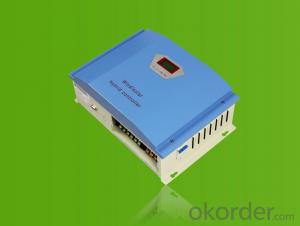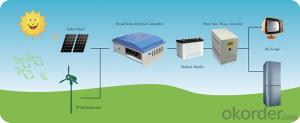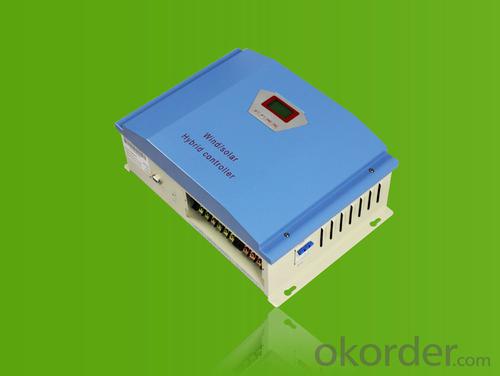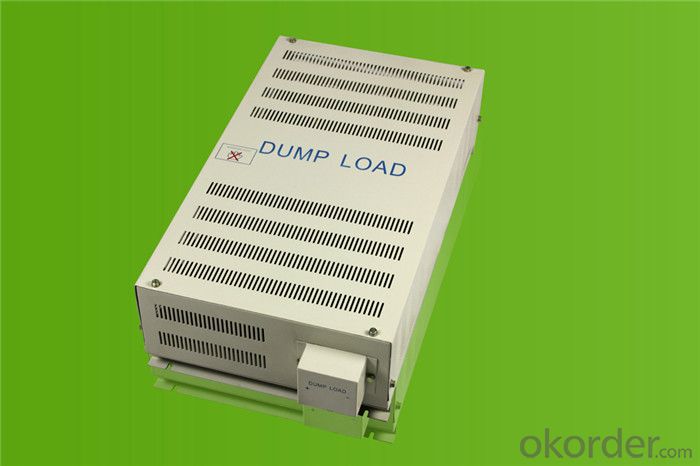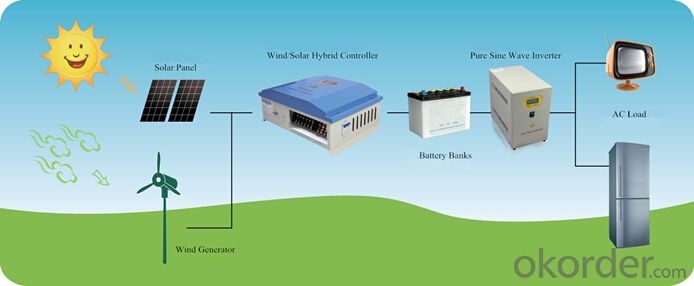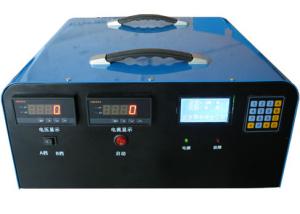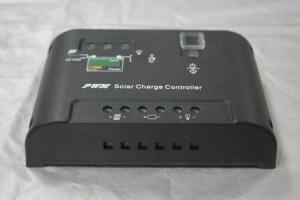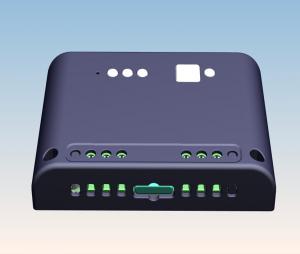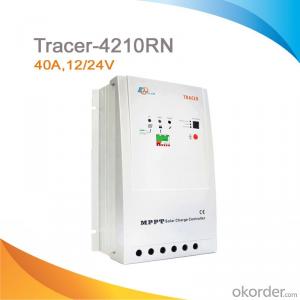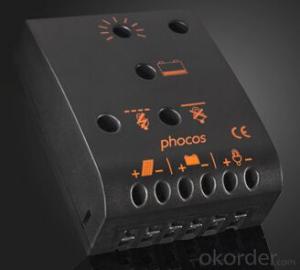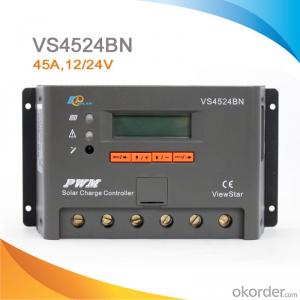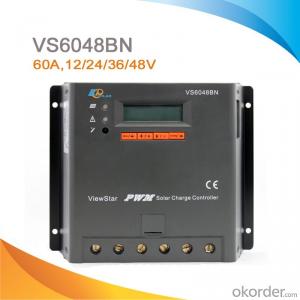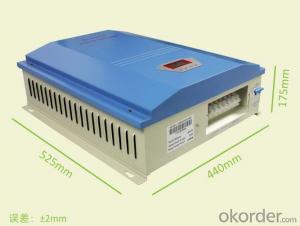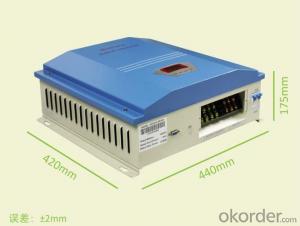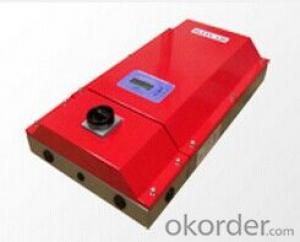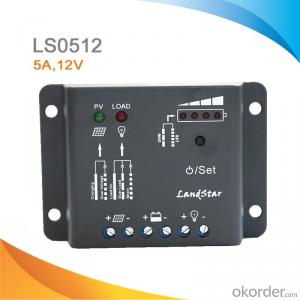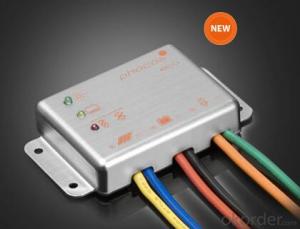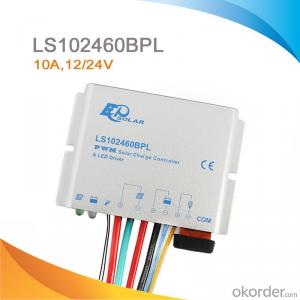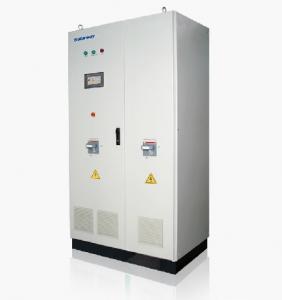Controller 5KW Wind Solar Hybrid PWM Stepless Unload Mode
- Loading Port:
- Shanghai
- Payment Terms:
- TT or LC
- Min Order Qty:
- 1 unit
- Supply Capability:
- 5000 unit/month
OKorder Service Pledge
OKorder Financial Service
You Might Also Like
I. PRODUCT INTRODUCTION
The wind/solar hybrid controller is control device which can control wind turbine and solar panel at the same time and transform wind and solar energy into electricity then store to the battery bank. Wind/solar hybrid controller is the most important part in off-grid system, whose performance has much effect on life expectancy and operational stability of the whole system, especially the battery expectancy. Or battery service life will be shortened by over-charge or over-discharge.
II. PERFORMANCE FEATURES
Superior military-grade components to ensure the product stability.
Perfect protection function, thus the system has higher reliability.
Check and set all operation parameters as requirement from LCD display.
Voltage limiting and current-limiting charge mode ensures battery in the best charging status.
PWM stepless unload mode, which burn the excess power into dump load, making the battery charging in best status.
III. APPLICATION AREAS
Stand alone wind/solar hybrid power station; Stand alone domestic household wind/solar hybrid power system.
Mobile communication base stations, expressway and other non-residential regions.
Coastal islands, remote mountainous, border posts for regions shortage of or without electricity.
Government demonstration projects, landscape lighting project.
IV. 5KW TECHNICAL PARAMETERS
Product Model | WWS50-48 | WWS50-96 | WWS50-120 | WWS50-220 | WWS50-240 |
Rated Battery Voltage | 48V | 96V | 120V | 220V | 240 |
Rated Wind Turbine Input Power | 5kW | 5kW | 5kW | 5kW | 5kW |
Maximum Wind Turbine Input Power | 7.5kW | 7.5kW | 7.5kW | 7.5kW | 7.5kW |
Wind Turbine Brake Current | 105A | 52A | 42A | 23A | 21A |
Rated Solar Input Power | 1.5kW | 1.5kW | 1.5kW | 1.5kW | 1.5kW |
Floating Charging Voltage | 58V | 116V | 145V | 266V | 290V |
Dimension (L x W x H) | Control Box:440×305×170 mm, Dumpload Box:770×390×180 mm | ||||
Net Weight | Control Box:7.5 kg, Dumpload Box:17 kg | ||||
Display Mode | LCD | ||||
Cooling | Fan | ||||
Protection Level | IP20(Indoor) | ||||
Quiescent Current | ≤20 mA | ||||
Protection Functions | Battery over charge; Battery over discharge; solar reverse charge protection; anti-reverse-connection protection; wind turbine over rotate speed protection; wind turbine over wind speed protection; wind turbine over voltage protection; wind turbine over current protection; manual brake protection; automatically brake protection; lightning protection. | ||||
Ambient temperature | -20~+55℃ | ||||
Ambient Humidity | 0~93%, without condensing | ||||
Working Altitude | ≤4000m | ||||
In order to serve our customers better. Our company can adjust parameters configuration according to customer’s requirement. | |||||
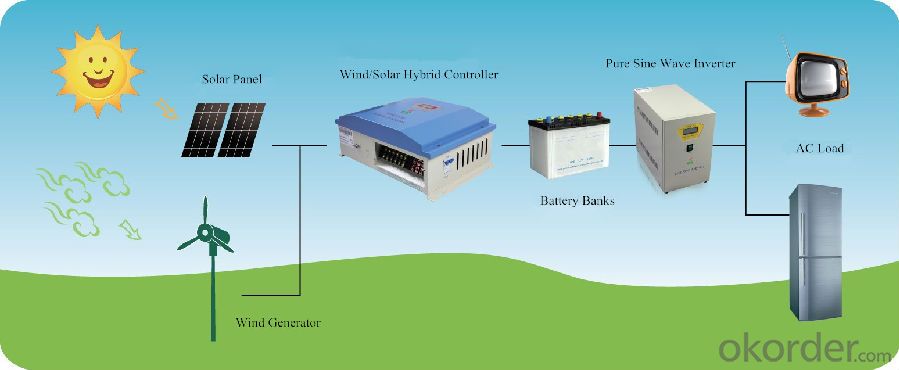
- Q: How do I determine the size of a solar controller for my system?
- To determine the size of a solar controller for your system, you need to consider the maximum current and voltage of your solar panels. The solar controller should be capable of handling the current and voltage outputs of your panels. Additionally, you should also consider the maximum load or power consumption of your system to ensure the controller can handle the required capacity.
- Q: How does a solar controller regulate the charging and discharging of batteries?
- A solar controller, also known as a charge controller or solar regulator, is an essential component in a solar power system that regulates the charging and discharging of batteries. Its primary function is to ensure that the batteries receive the optimal amount of charge from the solar panels and prevent overcharging or deep discharging, which can lead to battery damage. The charging process begins when sunlight is captured by the solar panels and converted into electrical energy. The solar controller connects the solar panels to the batteries and acts as an intermediary between them. It monitors the voltage and current output from the solar panels and adjusts the charging process accordingly. During the charging phase, the solar controller controls the flow of electrical energy from the solar panels to the batteries. It employs a technique known as pulse width modulation (PWM) or maximum power point tracking (MPPT) to optimize the charging efficiency. PWM adjusts the voltage and current supplied to the batteries by rapidly switching the charging circuit on and off. MPPT, on the other hand, constantly tracks the maximum power point of the solar panels to extract the maximum available power. The solar controller also incorporates various protection mechanisms to prevent battery damage. It uses voltage sensors to monitor the battery voltage and ensures that it does not exceed the recommended charging voltage. This prevents overcharging, which can lead to battery overheating or even explosion. Additionally, the solar controller monitors the battery’s state of charge and prevents deep discharging, which can reduce battery lifespan. Furthermore, a solar controller often includes additional features such as temperature compensation, load control, and display functions. Temperature compensation adjusts the charging voltage based on the battery temperature to optimize charging efficiency. Load control allows the solar controller to manage the power consumption of connected devices, ensuring that the batteries are not excessively drained. Display functions provide information about the system's performance, including battery voltage, charging current, and system status. In summary, a solar controller plays a crucial role in regulating the charging and discharging of batteries in a solar power system. It ensures that the batteries receive the optimal amount of charge from the solar panels while protecting them from overcharging and deep discharging. With its various control mechanisms and additional features, the solar controller helps maximize the efficiency and lifespan of the batteries in a solar power system.
- Q: Does a solar controller require any maintenance?
- Indeed, proper maintenance is necessary for a solar controller. While solar controllers are designed to be durable and dependable, regular maintenance is still required to ensure optimal performance and longevity. There are several common maintenance tasks that should be carried out: 1. Routine cleaning: Since solar controllers are typically installed outdoors, they are exposed to dust, dirt, and debris. Regularly cleaning the controller's surface, particularly the display panel, is essential to prevent any blockages or interference that may affect its functionality. 2. Inspection of connections: Over time, the connections between the solar controller, solar panels, batteries, and load may become loose. Regularly inspecting and tightening these connections guarantees uninterrupted power flow and mitigates potential issues. 3. Battery health monitoring: Solar controllers are responsible for charging and managing the battery bank. Monitoring the battery's state of charge, voltage, and overall health is crucial to prevent overcharging, deep discharging, or any other damage. If necessary, the battery may require maintenance, such as cleaning its terminals or equalizing the cells. 4. Updating firmware: Certain solar controllers have firmware that can be updated to enhance functionality, resolve bugs, or introduce new features. Checking for available updates and installing them as needed ensures that the controller is equipped with the latest software. 5. Physical damage inspection: Regularly inspecting the solar controller for any physical damage, such as a cracked casing or broken components, is important. If any damage is detected, it should be promptly repaired or replaced to avoid further complications. 6. System performance monitoring: Keeping track of the overall performance of the solar power system, including the solar controller, can help identify any irregularities or inefficiencies. This can be accomplished by monitoring energy production, battery charging/discharging patterns, and load usage. By consistently performing these maintenance tasks, the solar controller can function optimally and effectively manage the solar power system.
- Q: Can a solar controller be used with solar trackers?
- Yes, a solar controller can be used with solar trackers. A solar controller is responsible for regulating the flow of electricity from the solar panels to the batteries or grid. Solar trackers are devices that move the solar panels to follow the sun's path, maximizing their efficiency. By integrating a solar controller with solar trackers, the controller can effectively manage the energy output and ensure optimal performance of the solar panels throughout the day.
- Q: What is the role of a USB charging port in a solar controller?
- The role of a USB charging port in a solar controller is to provide a convenient and efficient way to charge electronic devices such as smartphones, tablets, or other USB-powered devices using the solar energy collected by the controller. It allows users to easily access and utilize the solar power stored in the controller for charging their portable devices without the need for an additional power source.
- Q: How do I protect a solar controller from lightning strikes?
- To protect a solar controller from lightning strikes, it is recommended to install a surge protector or lightning arrestor between the solar panels and the controller. This device will divert excess electrical energy caused by a lightning strike away from the controller, reducing the risk of damage. Additionally, ensuring proper grounding of the entire solar system can further minimize the chances of lightning-related issues.
- Q: Can a solar controller be used in a solar-powered surveillance system?
- Yes, a solar controller can be used in a solar-powered surveillance system. A solar controller is responsible for regulating the flow of power from the solar panels to the battery storage system. In a solar-powered surveillance system, the solar controller ensures that the battery is charged efficiently and protects it from overcharging or discharging, thereby ensuring uninterrupted power supply to the surveillance equipment.
- Q: What is the purpose of a solar controller?
- The purpose of a solar controller is to regulate and optimize the charging and discharging of batteries in a solar power system. It ensures that the batteries are charged efficiently and prevents overcharging or deep discharging, thereby maximizing the lifespan of the batteries and improving overall system performance.
- Q: What is the float charging mode of a solar controller?
- The float charging mode of a solar controller is a maintenance mode that keeps the battery at a fully charged state, preventing overcharging while allowing for a slow and steady trickle of power to compensate for any self-discharge.
- Q: Can a solar controller be used with a solar-powered wireless network?
- Yes, a solar controller can be used with a solar-powered wireless network. A solar controller helps regulate the power flow from the solar panels to the wireless network, ensuring that the network receives a steady and optimal power supply. This is important for maintaining a reliable and efficient operation of the wireless network.
Send your message to us
Controller 5KW Wind Solar Hybrid PWM Stepless Unload Mode
- Loading Port:
- Shanghai
- Payment Terms:
- TT or LC
- Min Order Qty:
- 1 unit
- Supply Capability:
- 5000 unit/month
OKorder Service Pledge
OKorder Financial Service
Similar products
Hot products
Hot Searches
Related keywords
